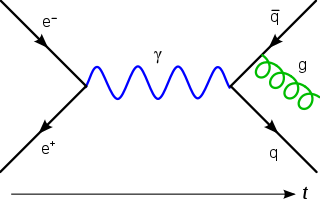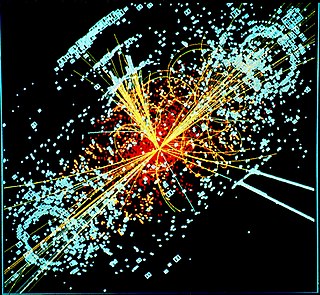
In particle physics, the electroweak interaction or electroweak force is the unified description of two of the four known fundamental interactions of nature: electromagnetism and the weak interaction. Although these two forces appear very different at everyday low energies, the theory models them as two different aspects of the same force. Above the unification energy, on the order of 246 GeV, they would merge into a single force. Thus, if the universe is hot enough (approximately 1015 K, a temperature not believed to have been exceeded since shortly after the Big Bang), then the electromagnetic force and weak force merge into a combined electroweak force. During the quark epoch, the electroweak force split into the electromagnetic and weak force. (For comparison, the current hottest man-made temperature is slightly higher than 1012 K.)

In particle physics, quantum electrodynamics (QED) is the relativistic quantum field theory of electrodynamics. In essence, it describes how light and matter interact and is the first theory where full agreement between quantum mechanics and special relativity is achieved. QED mathematically describes all phenomena involving electrically charged particles interacting by means of exchange of photons and represents the quantum counterpart of classical electromagnetism giving a complete account of matter and light interaction.

A scanning tunneling microscope (STM) is a type of microscope used for imaging surfaces at the atomic level. Its development in 1981 earned its inventors, Gerd Binnig and Heinrich Rohrer, then at IBM Zürich, the Nobel Prize in Physics in 1986. STM senses the surface by using an extremely sharp conducting tip that can distinguish features smaller than 0.1 nm with a 0.01 nm depth resolution. This means that individual atoms can routinely be imaged and manipulated. Most microscopes are built for use in ultra-high vacuum at temperatures approaching zero kelvin, but variants exist for studies in air, water and other environments, and for temperatures over 1000 °C.
In particle physics, the Dirac equation is a relativistic wave equation derived by British physicist Paul Dirac in 1928. In its free form, or including electromagnetic interactions, it describes all spin-1⁄2 massive particles such as electrons and quarks for which parity is a symmetry. It is consistent with both the principles of quantum mechanics and the theory of special relativity, and was the first theory to account fully for special relativity in the context of quantum mechanics. It was validated by accounting for the fine details of the hydrogen spectrum in a completely rigorous way.

The Standard Model of particle physics is the theory describing three of the four known fundamental forces excluding gravity in the universe and classifying all known elementary particles. It was developed in stages throughout the latter half of the 20th century, through the work of many scientists worldwide, with the current formulation being finalized in the mid-1970s upon experimental confirmation of the existence of quarks. Since then, proof of the top quark (1995), the tau neutrino (2000), and the Higgs boson (2012) have added further credence to the Standard Model. In addition, the Standard Model has predicted various properties of weak neutral currents and the W and Z bosons with great accuracy.

Renormalization is a collection of techniques in quantum field theory, the statistical mechanics of fields, and the theory of self-similar geometric structures, that are used to treat infinities arising in calculated quantities by altering values of these quantities to compensate for effects of their self-interactions. But even if no infinities arose in loop diagrams in quantum field theory, it could be shown that it would be necessary to renormalize the mass and fields appearing in the original Lagrangian.
In theoretical physics, a chiral anomaly is the anomalous nonconservation of a chiral current. In everyday terms, it is equivalent to a sealed box that contained equal numbers of left and right-handed bolts, but when opened was found to have more left than right, or vice versa.
In quantum electrodynamics, the vertex function describes the coupling between a photon and an electron beyond the leading order of perturbation theory. In particular, it is the one particle irreducible correlation function involving the fermion , the antifermion , and the vector potential A.
In theoretical physics, the Rarita–Schwinger equation is the relativistic field equation of spin-3/2 fermions. It is similar to the Dirac equation for spin-1/2 fermions. This equation was first introduced by William Rarita and Julian Schwinger in 1941.
In lattice field theory, fermion doubling occurs when naively putting fermionic fields on a lattice, resulting in more fermionic states than expected. For the naively discretized Dirac fermions in Euclidean dimensions, each fermionic field results in identical fermion species, referred to as different tastes of the fermion. The fermion doubling problem is intractably linked to chiral invariance by the Nielsen–Ninomiya theorem. Most strategies used to solve the problem require using modified fermions which reduce to the Dirac fermion only in the continuum limit.

This article describes the mathematics of the Standard Model of particle physics, a gauge quantum field theory containing the internal symmetries of the unitary product group SU(3) × SU(2) × U(1). The theory is commonly viewed as describing the fundamental set of particles – the leptons, quarks, gauge bosons and the Higgs boson.
The Thirring model is an exactly solvable quantum field theory which describes the self-interactions of a Dirac field in (1+1) dimensions.
In particle physics, the Peskin–Takeuchi parameters are a set of three measurable quantities, called S, T, and U, that parameterize potential new physics contributions to electroweak radiative corrections. They are named after physicists Michael Peskin and Tatsu Takeuchi, who proposed the parameterization in 1990; proposals from two other groups came almost simultaneously.
Newton–Cartan theory is a geometrical re-formulation, as well as a generalization, of Newtonian gravity first introduced by Élie Cartan and Kurt Friedrichs and later developed by Dautcourt, Dixon, Dombrowski and Horneffer, Ehlers, Havas, Künzle, Lottermoser, Trautman, and others. In this re-formulation, the structural similarities between Newton's theory and Albert Einstein's general theory of relativity are readily seen, and it has been used by Cartan and Friedrichs to give a rigorous formulation of the way in which Newtonian gravity can be seen as a specific limit of general relativity, and by Jürgen Ehlers to extend this correspondence to specific solutions of general relativity.
The Thirring–Wess model or Vector Meson model is an exactly solvable quantum field theory describing the interaction of a Dirac field with a vector field in dimension two.
The neutrino theory of light is the proposal that the photon is a composite particle formed of a neutrino–antineutrino pair. It is based on the idea that emission and absorption of a photon corresponds to the creation and annihilation of a particle–antiparticle pair. The neutrino theory of light is not currently accepted as part of mainstream physics, as according to the standard model the photon is an elementary particle, a gauge boson.
The soler model is a quantum field theory model of Dirac fermions interacting via four fermion interactions in 3 spatial and 1 time dimension. It was introduced in 1938 by Dmitri Ivanenko and re-introduced and investigated in 1970 by Mario Soler as a toy model of self-interacting electron.

In quantum field theory, the nonlinear Dirac equation is a model of self-interacting Dirac fermions. This model is widely considered in quantum physics as a toy model of self-interacting electrons.

Attempts have been made to describe gauge theories in terms of extended objects such as Wilson loops and holonomies. The loop representation is a quantum hamiltonian representation of gauge theories in terms of loops. The aim of the loop representation in the context of Yang–Mills theories is to avoid the redundancy introduced by Gauss gauge symmetries allowing to work directly in the space of physical states. The idea is well known in the context of lattice Yang–Mills theory. Attempts to explore the continuous loop representation was made by Gambini and Trias for canonical Yang–Mills theory, however there were difficulties as they represented singular objects. As we shall see the loop formalism goes far beyond a simple gauge invariant description, in fact it is the natural geometrical framework to treat gauge theories and quantum gravity in terms of their fundamental physical excitations.
In mathematical physics, the Gordon decomposition of the Dirac current is a splitting of the charge or particle-number current into a part that arises from the motion of the center of mass of the particles and a part that arises from gradients of the spin density. It makes explicit use of the Dirac equation and so it applies only to "on-shell" solutions of the Dirac equation.












